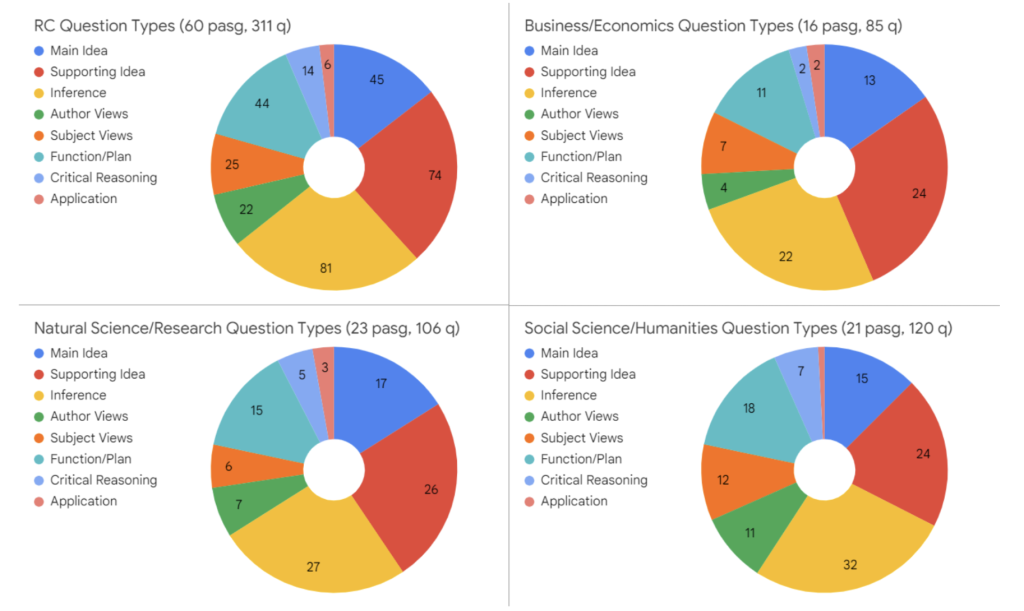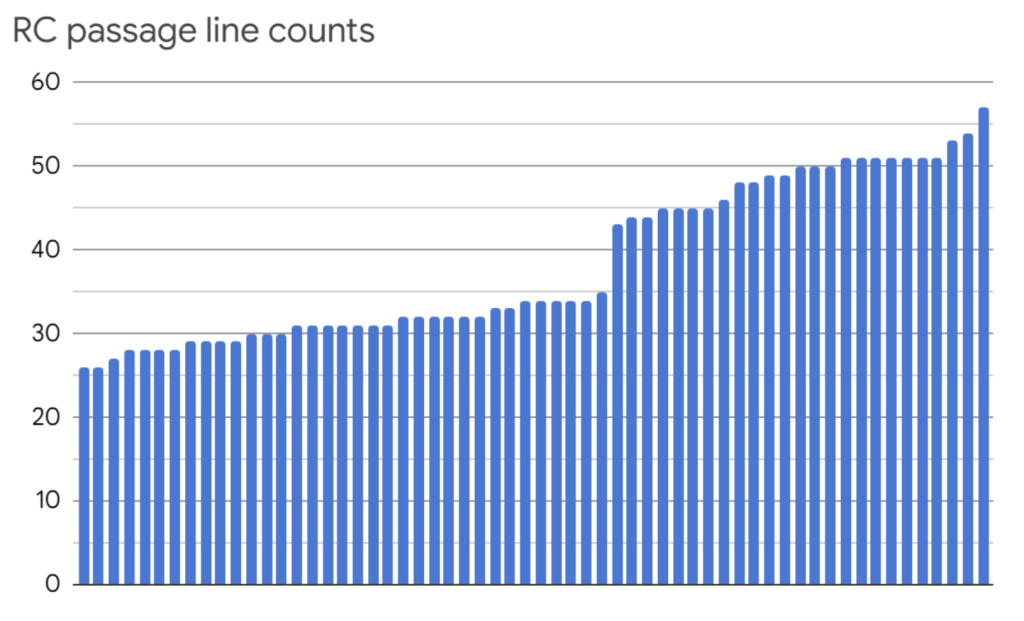Improving on GMAT Reading Comprehension appears difficult for many candidates because the relevant skills are less well-defined. Sentence Correction, Critical Reasoning, and the entire quant section have recognizable question types that can be mastered with the right knowledge and strategies.
By contrast, Reading Comprehension can feel frustratingly open-ended. How exactly does one get better at quickly absorbing the explicit and implicit information in a passage? And this question brings up another: how can we know what information will be tested? When everything about the passage is fair game, even a short passage can feel like an overwhelming amount of information.
Unlike any other standardized test I can think of, the GMAT does not allow you to peek at the questions before reading the passage! You cannot “cheat” by using the questions to tune your attention to certain details and ideas – you have to go one question at a time. This is just another way the GMAT makes itself an effective measure of meaningful skills.
On the quant section, taking away your calculator creates a space where you must think critically instead of bulldozing your way through problems via heavy calculation.
On Reading Comprehension, taking away your ability to preview the questions creates a space where you must actually read a passage and understand it. This is an important skill in itself, but it’s also how life – and business – work. You never know what you will be “tested” on.
Strategy for GMAT Reading Comprehension
Fortunately, on GMAT Reading Comprehension, both the passages and the questions that follow them fall into predictable categories. We will use data about these categories to lay out the best attentiveness strategy for GMAT Reading Comprehension.
First, let’s discuss the passage categories. GMAT Reading Comprehension passages fall into three categories:
- Business/economics
- Natural science/research
- Social science/humanities
Of the 60 RC passages in the GMAT Official Guide, Verbal Review, and Advanced Questions book, 16 are business/economics, 23 are natural science/research, and 21 are social science/humanities. There are fewer business/economics passages because these passages are heavily skewed towards easy/medium difficulty, while 26 of the 60 passages are labeled as hard.
GMAT Official Guide Reading Comprehension Categories
More important than passage categories are question categories. The GMAT Official Guide outlines six categories of Reading Comprehension questions:
- Main Idea
- Supporting Idea
- Inference
- Application
- Evaluation
- Style/Tone
Official prep materials will stick to these categories, but your actual experience while practicing Reading Comprehension is likely to lead you to identify the categories somewhat differently.
First, style/tone questions appear to be on their way out of GMAT Reading Comprehension. The Official Guide includes a brief section about them, but none of the 311 questions in the 60 passages studied appears to fall into this category.
Furthermore, it is helpful to recognize some sub-categories that fall under “Inference” and “Evaluation.” There are two special kinds of Inference questions that deserve special attention. Many questions ask about the author’s views or the views of a person/group featured in the passage. I call these people/groups the “subjects” of the passage.
Finally, you are unlikely to use the label “Evaluation” much in your thinking about Reading Comprehension questions. One class of “Evaluation” questions asks about the role a certain detail, sentence, or paragraph plays in the structure of the passage.
Others “Evaluation” questions are actually Critical Reasoning tasks based on Reading Comprehension passages! If you have any level of familiarity with Critical Reasoning, you will recognize these questions instantly
Thus, it is most helpful to think of Reading Comprehension questions in eight categories:
- Main idea
- Supporting idea
- Inference
- Author Views
- Subject Views
- Function/Plan
- Critical Reasoning
- Application
I list “Application” questions last because they are very rare. Of the 311 questions in the 60 passages studied, only six are Application questions – one for every ten passages. Since a typical GMAT Verbal Reasoning section has four Reading Comprehension passages, you probably won’t even see an Application question. You shouldn’t build your preparation or your reading strategy around these questions.
GMAT Reading Comprehension: Application Questions
But to satisfy your curiosity, here are the examples from the 60 passages in the prep materials:
- Which of the following most clearly represents an example of an “ecological service” as that term is used in line 20?
- Of the following topics, which would be most likely to be studied within the discipline of chemical ecology as it is described in the passage?
- Which of the following hypothetical experiments most clearly exemplifies the method of identifying species’ roles that the author considers problematic?
- Which of the following best describes employee behavior encouraged within learning organizations, as such organizations are described in the passage?
- Which of the following could best serve as an example of the kind of fictional plot discussed by Antonia Castañeda?
- The “serious problem” referred to in line 17 could be solved if which of the following were true?
How frequently do the more common question types appear? Here is a helpful graphic:

This distribution of question types informs the most effective reading strategy. Supporting Idea (detail) and Inference questions can be answered by knowing what the passage says and implies, but these are only half the questions you will have to answer.
GMAT Reading Comprehension Tips
In order to answer other types of questions, you will have to move beyond simply understanding the information expressed in the passage. The “next level” of reading comprehension can be summarized in three words: remember the author.
A passage does not exist of its own initiative; it was written by someone for a purpose. The information in the passage is selected and organized in order to achieve that purpose. Sometimes, the author’s purpose is simply to inform. But often, the author wants to attack or defend a certain view, to propose a method or strategy, or to compare or contrast two views or cases. Effective reading involves focusing your attention not only on what the passage is saying but also on what the author is doing.
Think of a Reading Comprehension passage like a novel, a movie, or a piece of art. A few paintings and movies don’t “say” much beyond what you can see on the canvas or the screen, but most of the time, the visual elements and the plot are a medium through which artists express their views on something bigger. There is what the script says, and then there is what the filmmaker “says” about life and the world through the fleshing out of the script.
If you watch The Matrix and all you get is that a few people are working to save the world from the Machines who have imprisoned humanity in a simulation, you missed a lot of what was being said. The Matrix is only superficially “about” Neo and Trinity battling Agent Smith and the Machines. It’s really about the nature of life in the world at the turn of the twenty-first century.
GMAT Reading Comprehension passages are not so symbolic or indirect, but the presence of an author who is “saying” something through the passage is no less real. Just as an artist or a filmmaker controls details to express their message, the author of a passage selects and organizes the information in order to achieve their purpose.
You should always read GMAT Reading Comprehension passages with two “tracks” of attention:
what the passage says | what the author is doing
In passages where the author has a purpose beyond simply informing the reader, you should think about what the author’s views are. And in passages with subjects, you should think about what those subjects’ views are and about how they relate both to each other and to the author’s views. Do two subjects agree or disagree about something? How do their views differ? What is the point of contention? Does the author agree or disagree with the subject? What points is he attacking or defending?
With practice, you will learn to recognize what matters about a passage. If it is a natural science/research passage that simply informs the reader about a phenomenon, a species, an experiment, a process, or a cause-and-effect relationship, you should focus your attention on understanding this topic itself.
If it is a social science/humanities passage that contrasts the scholarship of two historians, you should understand the difference between their views, as well as the author’s own perspective.
If you realize that a passage has a purpose beyond informing the reader, direct your attention to three tracks:
what the passage says | what the author is doing | what the author/subjects think
If this feels like too much to keep track of all at once, remember that the first track of “what the passage is saying” is actually the least important! Of course, you will have to have some grasp of what the passage is saying about the topic in order to understand what the author is doing and what the author/subjects think, but the big picture ideas of those second and third tracks are more important. If you encounter a supporting idea question or an inference question, you can always refer to the passage to find the answer. But if you read the whole passage and neglect to consider what the author is doing or
what the author and subjects think, then main idea questions, the author views questions, subject views questions, and function/plan questions will always trip you up.
As you practice, you’ll learn to recognize the key moments in a passage for these second and third tracks. But as a general rule, never start a new paragraph without pausing to consider what the author is doing and what the author and subjects think. If a passage doesn’t have enough paragraph breaks, do a “tracks 2 and 3” check-in at least every 15 lines. (separate paragraphs)
GMAT Reading Comprehension Tips: Passage Length
Speaking of lines, let’s discuss passage length. Here’s another helpful graphic:

GMAT Reading Comprehension passages fall into two well-defined length ranges: about 200-250 words and about 300-350 words. These length bands are reflected in the line counts seen in the chart above. The passages have line number marks to the left of the text, indicating every fifth line (5, 10, 15. . .). The three outliers on the right of the chart are all from the Verbal Review book and may be older passages.
The Official Guide (2022) and the Advanced Questions book seem to have an established word-count limit corresponding to 51 lines. Actually, the three shortest passages on the left of the chart are all from the Verbal Review book as well.
Back to question categories: one feature of the pie charts deserves special attention, so here’s the graphic again.

Notice how the green and orange wedges representing author views and subject views questions compare to the red wedges representing supporting idea (detail) questions.
For business/economics passages and natural science/research passages, supporting idea questions outnumber views questions two to one.
But for social science/humanities passages, views questions outnumber supporting idea questions! If you encounter a passage about history, literature, or anthropology/sociology, give extra attention to what the author and subjects think (track 3).
The next three articles in this series will apply the “three track” reading strategy to passages of each category: one business/economics, one natural science/research, and one social science/humanities.
Naturally, this whole process can be much easier if you have someone who can guide you along the way, like a one on one GMAT tutor. Here at Apex, we give every potential client the opportunity of a 30-minute complimentary consultation call with a 770+ scoring instructor.
Contributor: Elijah Mize (Apex GMAT Instructor)
